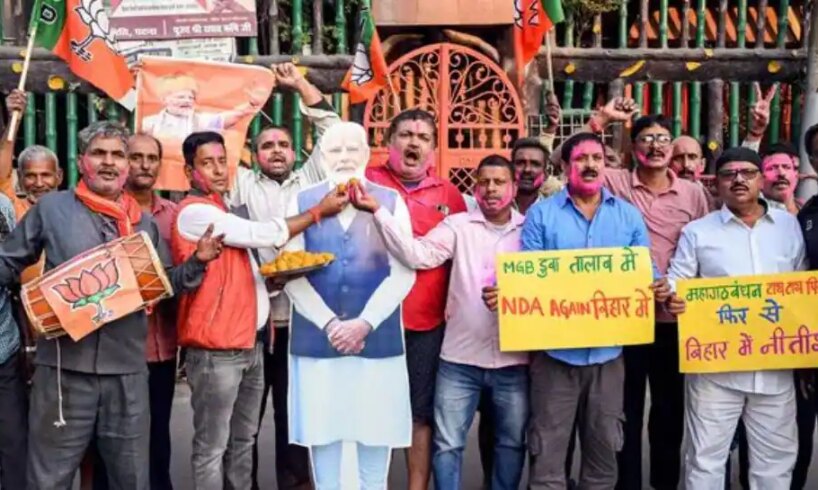
Bihar Election Results 2025: The assembly election outcomes in the state have showcased the power of silent groundwork over loud rhetoric. While political parties sparred in high-decibel campaigns, the Rashtriya Swayamsevak Sangh (RSS) worked behind the scenes, orchestrating a network of grassroots engagements that set the stage for the historic performance of the Bharatiya Janata Party (BJP) in particular and National Democratic Alliance (NDA) in general.
The Sangh’s strategy was meticulous. Thousands of drawing-room meetings, informal neighbourhood discussions and community conversations allowed volunteers to connect with voters on “pressing public issues”, subtly weaving in the Hindutva narrative.
Unlike conventional electioneering, this campaign avoided flamboyant rallies or celebrity endorsements. Instead, the RSS focussed on ensuring that when voting day arrived, BJP supporters simply showed up, trusting a message delivered over months of quiet persuasion.
Add Zee News as a Preferred Source
The Saffron Blueprint
The RSS’s influence became particularly critical in Bihar as political strategist-turned-politician Prashant Kishor’s Jan Suraaj Party entered the fray, attempting to challenge the BJP’s dominance. To counter any shift in narrative, at least 20,000 RSS volunteers worked at the grassroots, promoting nationalist ideology and linking local governance actions to the broader vision of national interest.
The results speak for themselves. Set to bag over 200 seats in the 243 member assembly, the NDA created history. The BJP is emerging as the single largest party, achieving nearly a 95% strike rate. Voters have once again demonstrated faith in Chief Minister Nitish Kumar and Prime Minister Narendra Modi, rewarding continuity and perceived governance stability.
Bihar, which went to polls in two phases on November 6 and 11, witnessed historic participation. The first phase recorded a turnout of 65.08%, followed by 66% in the second. Women voters, in particular, made a decisive impact, with their participation described as a “historic transformation” by the BJP. According to party sources, women voters cast ballots overwhelmingly in favour of candidates they believed would deliver development and good governance.
Delhi Comeback Through Quiet Persuasion
The RSS’s campaign model was not limited to Bihar. In Delhi, where the BJP had remained out of power for almost three decades, the Sangh organised roughly 50,000 drawing-room meetings, focussing on issues like anti-CAA protests, Delhi riots, air pollution and the Yamuna clean-up. These small and trusted community discussions helped the party make a historic return to power, ending the Aam Aadmi Party’s dominance.
Rather than relying on high-profile endorsements, the RSS leveraged individuals respected within their communities, letting casual and trusted conversations shape public opinion. The outcome confirmed the Sangh’s belief that sustained grassroots work is far more influential than momentary political theatrics.
Maharashtra, Haryana And Beyond
The saffron strategy extended to Maharashtra, where Prime Minister Modi’s appeal for unity, former CM Eknath Shinde’s Ladki Bahin Yojana and slogans like Uttar Pradesh CM Yogi Adityanath’s “batenge to katenge” helped consolidate Hindu voters.
Nearly 60,000 small-scale meetings under the “Sajah Raho” campaign addressed sensitive topics, from love jihad to governance issues, reaching deep into rural pockets.
In Haryana, traditionally dominated by Jat politics, the RSS orchestrated around 20,000 gatherings targeting non-Jat communities, including Punjabis, Banias, Brahmins and OBCs. The strategy enabled the BJP to expand into Dalit seats and Jat strongholds, reshaping the state’s political map.
Big Stage: Uttar Pradesh 2027
Looking ahead, the RSS is gearing up for an unprecedented nationwide outreach ahead of the Uttar Pradesh assembly elections in 2027. The month-long ‘Griha Sampark Abhiyan’, starting November 20, will see over 25 lakh volunteers reach more than 1 crore households across six organisational regions.
Literature and messaging promoting RSS ideology will be distributed, reinforcing the Sangh’s long-term strategy of embedding its ideas in everyday social and political consciousness.
From Bihar to Delhi, Maharashtra, Haryana and now UP, the RSS has silently demonstrated that political victories can be engineered not only with loud rallies and media blitzes, but with disciplined and persistent grassroots work that gradually shapes the electorate’s worldview.
Bihar’s 2025 results confirm what the Sangh has long believed: the power of patient and community-driven campaigning can outlast any temporary political storm.





